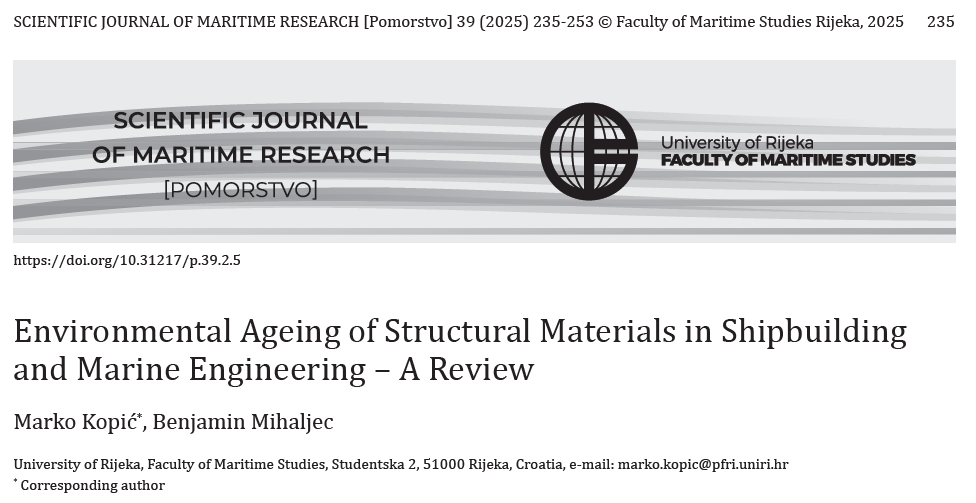Environmental Ageing of Structural Materials in Shipbuilding and Marine Engineering – A Review
Keywords:
marine engineering materials, material degradation, environmental ageing, mechanical propertiesAbstract
The mechanical properties of structural materials in shipbuilding and marine engineering are significantly affected by environmental stressors such as corrosive environments, UV radiation, and chemical treatments, all leading to material degradation. This review examines nearly 1,000 studies published between 2015 and 2025 to reveal key trends in the research on the impact of environmental factors on material degradation. The review has two parts. The bibliometric review
maps the structure of academic research and identifies patterns and trends, while the critical review provides research gaps and future research directions. Specifically, the study highlights that UV-C radiation accelerates surface embrittlement and strength loss in polymers, while chlorination promotes localized corrosion in stainless steels, notably AISI 316. A critical gap was identified in the limited research on combined environmental stressors, despite their real-world relevance in marine environments. The findings highlight the need for a multidisciplinary study of the interplay of various environmental effects on marine materials and structures. Also, there is a certain lack of long-term studies in the natural marine environment. Additionally, attention should be paid to the behavior of modern materials (composites, additively manufactured materials) to allow their faster uptake in the maritime industry.

Downloads
Published
Issue
Section
Categories
License
Copyright (c) 2025 Marko Kopic, Benjamin Mihaljec

This work is licensed under a Creative Commons Attribution-NonCommercial-NoDerivatives 4.0 International License.
Scientific Journal of Maritime Research understands the need for authors to disseminate and maximize the impact of their research. When submitting an article for publishing in Scientific Journal of Maritime Research, it implies that the Corresponding Author transfers, with the consent of all Coauthors, the copyright ownership in the referenced submission, including all versions in any format now known or hereafter developed, to the Scientific Journal of Maritime Research.
Copyright protects your original work and research material and prevents others from using it without your permission. Others will be required to credit you and your work properly, thus increasing its impact. Should your submission be rejected or withdrawn prior to acceptance for publication by Scientific Journal of Maritime Research, this transfer will be null and void.
Authors, users or readers of an article need clear instructions on how they can use the article. Scientific Journal of Maritime Research uses the Creative Commons Attribution-NonCommercial-NoDerivatives (CC-BY-NC-ND) 4.0 International License, which governs the use, publishing and distribution of articles by authors, publishers and the wider general public.
The authors are allowed to post a digital file of the published article, or the link to the published article (Scientific Journal of Maritime Research web page) may be made publicly available on websites or repositories, such as the Author’s personal website, preprint servers, university networks or primary employer’s institutional websites, third party institutional or subject-based repositories, and conference websites that feature presentations by the Author(s) based on the published article, under the condition that the article is posted in its unaltered Scientific Journal of Maritime Research form, exclusively for non-commercial purposes.




